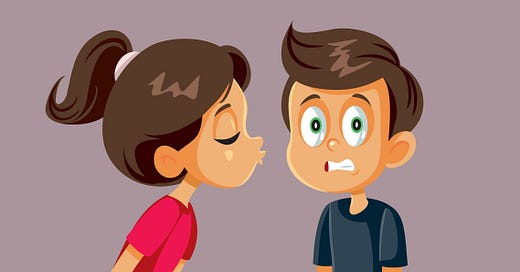The first time I played spin-the-bottle, I was so terrified that today I couldn’t even tell you whether or not I kissed the girl.
I remember everything else. I was 12. It was a Saturday afternoon. And almost as if foreshadowing, my friend Jamie and I had stumbled upon an old Playboy Magazine outside a trash dumpster on our way uptown.
We ran into two of our cutest classmates at Gsell’s drugstore, and before I knew it, the four of us were in Jamie’s basement sitting around a glass matchmaker. When the spin came to a stop, and the bottle pointed at Alisa and I, we headed for the nearby closet. I’d never experienced a room so dark, and that’s where the memory ends.
I was old enough to want to kiss either one of these girls in my imagination. I’m sure I already had. But at that moment, I was so damn scared of the potential embarrassment of doing it wrong that I just froze.
The irony? In an old photo album, there’s a pic of me at a friend’s fifth birthday party — and I’m kissing a girl I hardly knew in front of a roomful of people!
What was the difference between those two dispositions in those two different situations? Well, the younger me had no fear of — or even concept of — being laughed at. He wasn’t scared. He was down for the kiss. Period.
But the 12-year-old me had the benefit (or detriment) of several more years of living. Of doing things wrong — and worrying about it happening again. The 12-year-old had an awareness of what others thought. And a lack of confidence. He had fear.
The difference between these two versions of the same person speaks to the fears that we all take on as we grow up. We become worried about things that wouldn’t even make sense to us when we were the age of a toddler.
It’s true that some of our anxieties are hard-wired into our DNA. The “nature” case.
But most of the fears that we develop in our adolescent years come from experiencing the world around us. We see what’s desirable, and what’s frowned upon. What’s worthy of praise, and what has the potential to spark humiliation.
We take in information from our parents, our teachers, our peers — and we form impressions. The way we feel during or after dramatic experiences, especially in our youth, can camp out in our memories for a very long time. They accrue like layers of an onion — only we don’t notice or think about them in most of our waking hours.
Consider some of the things that may have scared you to the point of inaction — or still may. It might be public speaking. It might be changing careers or starting your own initiative. It might be getting close to someone and making yourself vulnerable in the process (the plot of nearly every rom-com). Or it could be as simple as not starting a new sport or hobby that you’ve thought about trying for years.
These fears that live in our minds — layers of the onion — are real. They are thoughts that become feelings. But by the same token, we can peel them back and un-think them. Sometimes this requires going deeper to figure out where that stupid layer came from in the first place. But there is always a path.
The most fertile ground for getting up the courage to confront our fears often appears when some life-crushing event has just sent us to the mat. A divorce. A bankruptcy. A disease. A massive personal loss.
When we feel real pain, or even worse, the desperation that can branch out from it, that’s when it seems easier — even imperative — to shed some of the bullshit that’s been bouncing around in our brains. I know that when I’ve spiraled down into that dark place, it’s been the very best space to start chipping off the paint.
Once we start peeling back those layers of judgment or long-existing insecurity, the truer version of ourselves begins to emerge; the authentic person we were once just beginning to get to know — without even knowing it.
The more we confront these monsters in our minds, the more we grow into the people we were always capable of becoming. We keep getting closer and closer to that core of the onion.
The fear I described above about screwing up that kiss as a kid was soon overcome. But the memory remained. And the number of fears that piled up in my psyche during those adolescent years was pretty hefty. Many of them have been addressed; plenty more are waiting out on the porch.
Facing our fears isn’t easy. That’s why they’re called “fears.” And no matter how many layers you still may have that quietly block an unrealized potential, nearly all of them grew there in the first place — and remain there — for a reason.
Yet when we find the inner mettle to meet our old specters face-to-face in the ring and start punching, it can often lead to liberation. Exhilaration. Even new expectation.
That big onion sitting on our shoulders is always waiting for us to thin out the layers that don’t need to be there. And while it’s true that getting down to the very core of who we are as individuals is an elusive, lifelong process — the real living always lies in the learning.
Peel it back.





